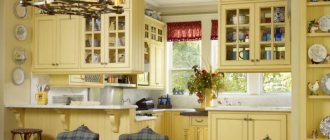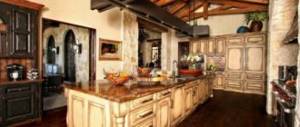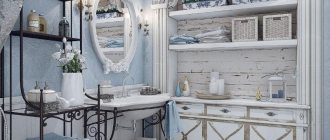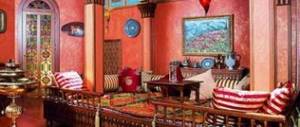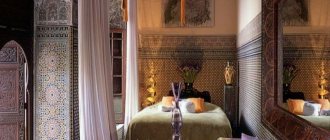Characteristic features of an Italian style kitchen
- Focus on luxury and aesthetics.
- Predominance of natural materials.
- The presence of a spacious kitchen unit.
- Active use of decor, frescoes, mosaic panels, paintings.
- Warm colors.
- The organization of the interior is in the Italian style of sweet negligence, which gives it a special charm and comfort.
Italian style kitchen lighting
Italy is a southern country, so rooms of this style always have a lot of natural light. In the case of our climate, everything is not so simple here, so you will have to compensate for the lack of sunlight with an artificial lighting system in the kitchen.
For this purpose, yellowish or white spectrum lamps are ideal options. Moreover, the glow should always be warm and diffused. Such lamps can be mounted in beams on the ceiling or pieces of furniture.
A chandelier is required in the center of the kitchen. It is made in a forged style, which is close to the medieval one. Additional light accents are created by wall lamps. It is best if they are made of ceramic or metal. In general, in the Italian style it is appropriate to stylize light sources to resemble antiquity.
The basis of Italian style
Despite the apparent carelessness, the style of the sunny country, which is also called Tuscan, is thought out to the smallest detail: it seems that everything is arranged, hung, but every thing has its own meaning and stands in its place.
With external rustic simplicity, everything when creating the design of an Italian kitchen is subordinated to a common meaning, a single harmony.
Kitchen decor combines elements of everyday life and the environment. The Italian direction of ethno-style is characterized by increased comfort, which attracts kitchen owners. If they enjoy their surroundings, the food tastes better.
Distinctive features of the Italian style: correctly selected colors, emphasis on furniture, correctly selected decorative items.
The unity of the three components will create a harmonious, ergonomic and stylish space.
Italy is a country that honors family traditions, which is why the interior often displays a certain layering, when each generation brings something of its own, so the style allows for the use of rustic finishes in the decoration, and a mosaic panel appearing next to the rough plaster. Blurriness and wear will only complete the stylization.
Classic interior of Italian cuisine
Classical features in the interior of Italian cuisine date back to the era of antiquity. When talking about classical design, one cannot fail to mention such trends as Baroque, Rococo, Biedermeier or Empire.
Despite the fact that these are different styles, they have something in common - the desire for wealth and luxury. Indeed, the classics “scream” with their “palace” luxury, scope and deliberate pomp.
To decorate a room in a classic Italian style, you should focus on bulky and chic furniture made of wood with elements of gilding and velvet.
Renaissance paintings framed with ornate baguettes, candelabras, and bohemian chandeliers have characteristic features of this trend.
When decorating a classic Italian kitchen, it is also important to adhere to balance, correct forms and symmetry. Despite the bulky and luxurious fittings, there should be no unnecessary items in the room. The design of a classic kitchen combines nobility, grandeur, regularity and high cost.
Characteristic features are the stucco ceiling and walls.
Most often, sculptures are used as an accessory. This direction is rich in various half-columns, columns and moldings. You can also find order decor framing door openings. The arch between the kitchen and dining room looks very stylish.
The classic direction of the Italian kitchen interior embodies grace and moderation, but in no way pretentiousness.
Classic interior
Classical features in the interior of Italian cuisine date back to the era of antiquity. When talking about classical design, one cannot fail to mention such trends as Baroque, Rococo, Biedermeier or Empire. Despite the fact that these are different styles, they have something in common - the desire for wealth and luxury. Indeed, the classics “scream” with their “palace” luxury, scope and deliberate pomp.
The classic interior of Italian cuisine is always scope and luxury
Attention! To decorate a room in a classic Italian style, you should focus on bulky and chic furniture made of wood with elements of gilding and velvet.
Renaissance paintings framed with ornate baguettes, candelabras, and bohemian chandeliers have characteristic features of this trend.
When decorating a classic Italian kitchen, it is also important to adhere to balance, correct forms and symmetry. Despite the bulky and luxurious fittings, there should be no unnecessary items in the room. The design of a classic kitchen combines nobility, grandeur, regularity and high cost.
Furniture for a classic Italian-style kitchen looks solid and is most often made of solid wood
Characteristic features are the stucco ceiling and walls. Most often, sculptures are used as an accessory. This direction is rich in various half-columns, columns and moldings. You can also find order decor framing door openings. The arch between the kitchen and dining room looks very stylish. The classic direction of the Italian kitchen interior embodies grace and moderation, but in no way pretentiousness.
Read on the topic: Mediterranean-style kitchen: ideas, types
You can embody Italian style even in a small kitchen
Modern interior of Italian cuisine
This direction is completely different, because not a trace remains of classical pomp. Modern trends bring new styles, for example, modern, neoclassical, art deco and others. However, the very authenticity of the spirit of Italy is preserved, adapting to modern design.
The sophisticated and luxurious elements of classic interiors are replaced by the sophisticated and graceful lines of modern Italian style.
You can recreate it in your kitchen, knowing the main features of the Italian interior:
- Use of environmentally friendly materials. In the modern world, the fashion for eco-products has also affected interior design. Therefore, the materials used for Italian cuisine must be natural, for example, wood painted in a dark color or natural stones.
Marble or granite are often used.
- Forged items look very stylish. These could be candlesticks, small lamps, kitchen table legs, etc. Such products will add grace and moderation to the room.
- Lighting is an important thing when decorating an Italian kitchen in a modern style. Since the room requires as much light as possible, a baroque crystal chandelier in the center of the ceiling, as well as forged candlesticks, would be appropriate. These light sources can generally convey the spirit of modernity and make the room more comfortable.
Since Italy is a sunny country, modern kitchen style includes only warm shades.
The color range varies from ivory to pastel, white, beige, and cream tones. However, there are rich and bright colors inherent in the Mediterranean style. Thanks to the natural and geographical features of the Mediterranean, the Italian kitchen interior “comes to life” in a new way, as the color palette is filled with bright yellow, green and blue tones.
Many accessories bring life to the kitchen room. Living plants in pots and vases, curtains both plain and multi-colored, various paintings, etc., will not be out of place on the windowsills.
What is an Italian style kitchen?
The design of the welcoming and lively space includes natural shades and bright colors of the Mediterranean Sea.
Shades of ochre, burnt orange clay, terracotta, soft yellow and brilliant blue describe the relaxed yet elegant Italian lifestyle, in which cooking and eating is one of the main pleasures, if not the most important thing.
An Italian-style kitchen looks very organic and gives a feeling of homely warmth and comfort.
Interior Features
The interior of Italian cuisine is made using natural materials. Countertop and floor surfaces should have a natural look - Italian style favors matte stone or granite countertops, terracotta or slate tile floors, often with unique mosaic patterns.
Culinary utensils and equipment must be in a visible place, in table drawers or hanging on antique racks
The common theme is relaxed elegance and luxurious, hedonistic living - Italian cuisine will make you happy to spend a long time and will make you want to return again and again.
Lighting
Lighting designs for Italian kitchens tend to match a bright and airy space with plenty of natural light. Natural motifs are a must in the Italian kitchen - flowers and plants placed in strategic positions in windows, on window sills and tables, combined with tapestries or mosaics depicting country scenes or flora and fauna.
The interior features exposed wood ceiling beams - a common feature in Italian kitchens - as do cabinets made from high-quality natural wood. They can be dyed or have a natural color
Equipment and accessories
The design of appliances and accessories also shapes the design spectrum of Italian kitchens, from simple stainless steel designs typical of the Tuscan style, to vintage or more modern styles in bright and bold colors. In general, the more natural the overall design looks, the better it will pair with appliances and kitchenware that are simple, traditional in design as opposed to something more modern or contemporary.
Furniture
Finally, an important element of the interior is furniture. The Tuscan style is characterized by the use of wood, even rough finishing (but without splintering fragments).
It is highly desirable that the windows of your Italian kitchen overlook the sea or wildly flowering bushes, flower beds or beautiful trees with stone houses. If this is not the case, then you can hang a large picture on the wall with a view of Florence or Naples
The Mediterranean style of Italian kitchens is brighter, and modern furniture can come with sleek surfaces - stainless steel tables, stools and chairs painted in bright and bold tones of orange, blue and green.
Interior features of Italian cuisine in the Art Nouveau style (video)
Italian style furniture
It is difficult to imagine an interior without furniture, so it is clear why it is often chosen before finishing. It rarely acts as a background, especially in this design direction. Here the headset sets the tone.
Italian-style furniture has classic features - carved facades, decorated with moldings, imitation columns, and floral motifs.
Such sets are often made for the ceiling, complemented by skirting boards, decorated corners, etc. Although many parameters will be different, usually the headsets are made of natural wood. Usually these are quite expensive varieties that look exceptional even without painting.
More affordable breeds are best used with additional finishing, especially since stylish Italian interiors are often painted in a wide range of shades.
In general, the furniture in such a kitchen will have antique features - classic, traditional, monumental, but still temperamental thanks to the color. The set can be specially aged, covered with craquelure varnish or patina.
If you are decorating the kitchen in a simpler rustic interior, then the space should include a dining table - large, wooden, without painting or excessive decoration.
For an ordinary Italian family, there will be benches next to it, albeit with backs - for comfort. In a more expensive setting, in which more classic touches can be seen, it is better to move the dining room into a separate room.
Italian style kitchen furniture
Italian style kitchen furniture immediately attracts attention. It is so massive and monumental that it becomes clear that the furniture pieces are made to last.
Solid wood, decorated simply but laconically, is optimal for reproducing such beauty. The facades are decorated with panels, carved inserts, and sometimes with openwork decor. In most cases, the natural color of the wood is preserved, but the surface is coated with a clear varnish to protect and improve the external characteristics of the furniture item.
Advice! You can add fittings in the color of copper, brass or bronze to the furniture.
The shape of the furniture is symmetrical. It is functional due to its capacity and ergonomic. Some shelves may have light or checkered textile curtains instead of fronts. Or they may be completely open.
A countertop made of natural stone, mainly marble, is used as a working surface.
The set in an Italian kitchen can be arranged in any way, but so that there is sufficient free space. The choice of layout depends on the area of the kitchen and its geometry. So, here are the options that can be used in each individual case:
- in an elongated room - straight layout;
- in a square kitchen - L-shaped arrangement;
- in the spacious kitchen - U-shaped arrangement of furniture;
- The spacious square kitchen has an island layout.
Only a large table with massive legs and embossed edges is suitable for the dining area. In shape it is a cross between an oval and a rectangle. To accommodate numerous relatives and friends, wide benches and chairs with rounded backs are used.
For a spacious kitchen area, the presence of a fireplace is also suitable, which will only add comfort and a homely atmosphere. To place a beautiful service, an aged sideboard with an elegant shape and painting is used.
A stylish addition to an Italian-style kitchen will be a section for storing wine bottles, in which they are located horizontally. This piece of furniture can stand on the floor or be equipped above the work area in the form of a shelf.
Italian cuisine space
Usually this is a large kitchen, a huge area of which is dedicated specifically to the working area. In old Italian houses, the dining room is usually moved to another room. Maintaining family traditions does not allow you to refuse to eat together.
However, preparing dinner for the family is one of the housewife’s favorite pastimes, so she should be given enough freedom.
Italian style in the kitchen interior involves a lot of functional furniture. As a rule, this is an island set. The main part can be represented by any convenient option - corner, U-shaped, straight or parallel furniture. The choice of kit depends on the shape and area of the room.
There may be a small area for eating - for a morning cup of coffee, for a glass of wine during a friend’s visit, for an afternoon snack for a toddler who has come home from school while mom is preparing dinner.
Most often this is a part of the island that serves as a bar counter. Such an area near the window looks luxurious - then the window sill will play this role. Although there may also be a desktop here.
Needless to say, the easiest way to organize such a comfortable and sunny space is within the walls of a private home. Here you can plan it even at the construction stage. In an apartment, most likely, you will have to combine rooms.
An Italian-style kitchen-living room will be a little different than just a kitchen block.
It is imperative to arrange a dining area. And the dining group will, perhaps, take the leading role in the interior - just like in the classic style, where family lunches and dinners are a real ritual and tradition passed on from generation to generation.
Italian style kitchen: decoration, furniture and appliances
We can safely say that the interior of an Italian-style kitchen skillfully interweaves the chic of ancient culture and the simplicity of the rural way of life. Italians are life-loving people, so they do not remain indifferent to luxury, natural materials and rich finishes. But no less, they love comfort, honor family traditions and idolize the comfort of home. This symbiosis of two completely opposite directions allows you to create an extraordinary design of a kitchen space, where it is pleasant to create culinary masterpieces, receive compliments from friends about a delicious treat, or simply have a meal with your family. Let's decide what characteristic features are inherent in Italian cuisines?
- Elegance. Even the rough finish of a rustic kitchen does not spoil the elegant look of the room. What is it expressed in? In graceful lines and curved shapes, which are visible in furniture and decoration. Calm colors also contribute to the formation of a sophisticated interior.
- Naturalness of finishing materials. Taking all the best from country style, Italian-style kitchen design is filled with natural finishing materials - natural stone, wood, ceramic tiles. Metal and glass are also present in small quantities, but do not predominate in the interior. Instead, an atmosphere of comfort, calm and steadfastness is created by cute trinkets made from natural materials with your own hands, mosaic panels, stone floors, rough wooden beams and solid wood furniture.
- Wooden furniture. We can say that this is the basis of the Italian style. A good quality kitchen set is taken as the basis when decorating a kitchen in this style. It must be made of natural wood of valuable species and can be decorated with decorative carvings. This is exactly the case when a buffet would be appropriate in the kitchen, containing all the necessary utensils for a long meal, as well as a massive dining table that can withstand the weight of all the dishes and treats.
Kitchens in Italian style Provence photo
- Kitchen appliances. Naturally, modern technology makes the cook’s work easier, and it’s not easy to give it up. Therefore, the Italians willingly let her into their territory. The only nuance that can be noted here concerns the color of large household appliances - metallic-colored appliances will look best together with natural finishing materials and wooden furniture. The same applies to furniture fittings.
Above we described the main components of an Italian-style kitchen. Next, let's look at the interior of such a kitchen in more detail. In the meantime, we invite you to familiarize yourself with the design options for Italian kitchens presented in this video.
Accessories for luxury Italian style
To create Italian chic, interior designers actively use various accessories:
- • Hand-painted clay vases, bottles entwined with threads, transparent containers for bulk products on special shelves, small jars for seasonings on carved wooden stands.
- • A large number of pictures and decorative plates on the walls, sconces, figurines, candlesticks.
- • Wicker dishes, baskets, drawers for cutlery, openwork tablecloths.
- • Panels on the wall with landscapes or still lifes look very interesting. The panel is placed both above the tabletop and as an independent interior object on the wall. Images of the beauties of Italy and blooming vineyards will look great.
It is important to maintain the general style and color scheme of the interior so that the panel does not look like a foreign element.
With the help of accessories, the effect of slight negligence and special home comfort is achieved, which is characteristic of the Italian style. If it is preferable to choose furniture in warm, soft shades, then here you can experiment with small details and add rich colors.
Most often, decorative elements are brought directly from Italy along with the unusual atmosphere of this colorful country.
Ceiling, walls, floor
Parquet or laminate, tiles are often used as flooring; to divide the kitchen into zones, it is possible to use two materials together. If the floor may not be monochromatic and have some kind of ornament or pattern, then the walls should be made in one color. Since the main element in an Italian-style kitchen is furniture, the walls will only be a background for it.
Plaster looks very interesting, but you can limit yourself to a more affordable option - painting.
Designers suggest simply painting or plastering the ceiling in classic white, but not snow-white with a blue tint. You can add texture to the surface. If the space of the room allows, special wooden beams on the ceiling or walls, painted in a dark color, will look especially “Italian”.
Stretch ceilings and shiny surfaces should not be used, as well as boxes and multi-tiered structures. Like the walls, the ceiling is just a backdrop for exquisite furniture and decorative elements.
Curtains for the kitchen in Italian style
In an Italian-style kitchen, only curtains are allowed. There cannot be any roller blinds or curtains here. It is advisable that curtains for the kitchen be made of light and practical materials, since in the kitchen there is a high risk of contamination and situations often arise when the linen needs to be washed.
Important! The color of the curtains should always be combined with the shade of the furniture.
In the case of very low room heights, ceiling cornices are used to somehow hide this defect.
The main feature of Italian-style curtains is the impossibility of completely opening them. Their design includes high-mounted tie-backs, which look great on large and arched windows. The lower part of the curtain either lies on the floor or rises above the floor at a distance of 1 cm.
Features of selection of household appliances
When decorating a kitchen in Italian style, designers prefer to hide household appliances behind the façade in special niches. Modern technology is a foreign detail for this style. If it is not possible to disguise, then select appliances with antique-style elements, for example, gas stove handles with monograms or made of wood-look material.
The best solution would be built-in household appliances; in this case, the set itself is ordered according to individual sizes, taking into account the characteristics of the room.
Small kitchen in Italian style
A small room can also be designed in Italian style. But, in the case of a cramped area, you should think about moving the dining area, for example, to the living room. This is done because otherwise there will be no free space left in the kitchen, which is so necessary in this direction.
In a small Italian-style kitchen you will feel even more of a good homely atmosphere. But here it is important not to overdo it with the design. It is best to choose only light-colored furniture and cladding. The set can be several tones darker or lighter than the color of the walls.
You will have to give up a lot of open shelves and exposed decor and make do with a few elements that support the concept. This is the only way to avoid making an already small room smaller.
Italian style: history of origin
Whatever one may say, Italy has always been famous for its craftsmen and was considered a trendsetter. The exquisite creations of Italian designers delighted the whole world, from new clothing collections to interior items.
Anyone who has visited Italy once will definitely want to return there again.
This country has a lot of interesting things - narrow streets, delicious dishes, old squares, as well as melodic Italian speech. This is all the ardent, original and bright Italy. These are the features that the Italian interior has incorporated.
Oddly enough, it was in Italy that the word “design” originated in the 16th century. However, its essence differed significantly from the modern interpretation. At that time, design was the concept of a future work, which was developed by its creator.
Design in its modern understanding, as an activity of artistic construction, began to be used thanks to the work of such Italian masters as Gio Ponti, Gaetano Pesce, Ettore Sociss and others.
The room, made in Italian style, combines such incompatible things that it makes a strong impression on any visitor. Thus, palace chic and provincial simplicity, indestructible traditions and modern spirit create an incredible atmosphere of the Italian interior.
Just like the speech of Italians, which has a large number of dialects and dialects, there are many directions in this style.
For example, “trattoria” is a style for decorating a kitchen, reminiscent of a small cafe in Italy. It is characterized by wicker baskets for bread, a red and white checkered tablecloth on the table, clay pots and jugs with fresh and dried flowers, as well as bottles filled with wine and olive oil.
Having gone through many years of history, the Italian style has absorbed various features.
To decorate your room and preserve the true spirit of Italy in it, you can combine various options. This includes wood and natural stone for flooring, ornate furniture and a multi-level ceiling.
Due to the variety of interior solutions, you can understand the history of the development of the Italian style in the kitchen interior. There are classic and modern styles, which have their own features and characteristics, which will be discussed a little later.
If you are a fan of Italian style, then you have extraordinary taste. The following information will help transform an ordinary kitchen into a sophisticated and chic space.
Beautiful and practical kitchen interior in Italian style
Italian design is known for being elegant, stylish and pompous. Tuscan design delights with its simple luxury, and you will feel warm and cozy in a Tuscan interior. A low vaulted brick ceiling, hexagonal terracotta flooring and cozy wood or wood-look furniture in such a kitchen retain natural warmth and make the atmosphere intimate. For such a kitchen, decorative or even functional copper pots, vases and a large wrought iron chandelier in the center of the table are acceptable. In Italy, the kitchen is the heart of the home, and it must be spacious enough.
If funds allow, then your interior can recreate all the splendor of the Old World splendor by imitating a hand-painted cathedral ceiling and hanging a two-tier chandelier
This kitchen exudes an Italian Renaissance feel, while the furniture and accessories can be done in a traditional 19th century style. The most exciting part of the kitchen is the 16th century fireplace, but this is, of course, subject to the appropriate facilities and permissions.
One of the purely Italian motifs is frescoes, which can easily be imitated with special wall tiles. The brick bas-relief under the vaulted ceiling subtly imitates the kitchen ceiling, contrasting with the stone walls.
Modern kitchens Italy (video)
Color solution
The color palette in which a kitchen in the style of sunny Italy is usually decorated is sometimes called bright. This is not entirely true; not bright, but rich, rich shades, close to natural, should emphasize the style of the kitchen space.
Palette
To decorate an Italian interior, choose colors:
- Olive;
- Grassy;
- Terracotta;
- Honey;
- Wine;
- Mustard;
- Orange.
The color scheme will depend on the overall design solution. Light furniture is acceptable - beige, milky, light olive and other colors against the background of more saturated shades of wall decoration.
Options for dark, deep colors of furniture against light walls are also possible.
Combinations
You can combine all shades in different ways, because the main thing in Italian cuisine is color and light. Rich natural colors - brown, ocher, pistachio, wine red - ideally combined with beige, peach, white, cream colors.
Sky blue, ivory, light orange shades complement and dilute the rich colors, resulting in a harmonious relationship that creates a homely, cozy atmosphere.
Important! The Italian style does not allow white color in interior design - neither when decorating a room, nor for furniture. Only occasionally it is found in decorative elements.
Italian cuisine can be made either in a single color scheme using several shades of the same paint , or in contrasting colors:
- Light olive color of the walls and rich grassy green shade of the furniture;
- Coffee shade when decorating the walls, dark brown color of cabinets and countertops;
- Light sand, combined with olive, pistachio;
- Sandy, combined with the deep, rich color of red wine.
The main features of an Italian style kitchen
The first rule is a lot of air in the room. Italians have always lived in spacious houses. They cook in rooms filled with light and space. Therefore, you should allocate a large room for the kitchen. Or combine the kitchen with the room located next door. Both the kitchen and the living room will benefit from this in functional terms.
The color of the walls can be either pastel or very rich.
This spacious room should be filled with features of Italian style. And the lifestyle of old Italy implies a reminder of the rural idyll in interior design. First of all, these are elements made of wood, stone, earth and water.
Finishing materials
The closeness to nature that distinguishes the Italian style in the kitchen interior is expressed not only in the choice of color, but also in the materials used to decorate the walls, ceiling and floor of the kitchen.
Walls
Italy loves space, so the style suggests that there should be a lot of space in the kitchen. Then natural materials would be appropriate here:
- Wood, and it may not be planed;
- Stone (marble and others).
The materials can be anything, except for cheap-looking colorful wallpaper; it is better to choose plain coatings for the walls - this can be painting, decorative plaster, painted wallpaper and others. Ceramic tiles can be used in warm colors: sand, olive.
Mosaic panels will fit harmoniously into the decoration of the walls. Multi-colored stained glass windows are appropriate on walls, doors, ceilings, and kitchen furniture doors.
Important! No plastic is allowed in an Italian-style kitchen. Doors, window frames, window sills - only wood.
Floor
It is better to leave the floor wooden. The flooring must be able to withstand the weight of massive furniture. You can choose parquet or porcelain slabs under which to install a heating system: Italian style does not imply carpeting the floors.
Ceiling
It is better to leave beams on the ceiling that are painted with dark paint or that have retained the natural color of the wood. If the height allows, stucco molding, plaster moldings, and ceiling painting can be used.
If the height of the room is small, make suspended ceilings to match the walls. You can choose a mirrored ceiling, which visually increases its height.
Italian style kitchen - interior design secrets
The desire to turn an ordinary kitchen into a corner that evokes thoughts of sunny Italy can be realized with high-quality Italian furniture. In this case, special attention is paid to creating a cozy atmosphere. Indeed, in the mentioned country, it is the kitchen that becomes the place where the whole close-knit family gathers for a good family dinner or lunch. Meetings with friends often take place here.
Kitchen Turati Cucine 3 – View
What materials to use
Naturalness is highly valued in Italian interiors. There is no such thing as wood here. Pine with a reddish tint, noble oak and other species are used in furniture, flooring and wall coverings. Massive beams bring a special charm to the decor. However, this design element is more typical for a country house. You can simply whitewash the ceiling or cover it with textured plaster.
Italian style kitchen – Martini Mobili Sins of Gluttony
The stone also takes its place of honor. They were the ones that were traditionally used to lay out the floors in an Italian home. The style is very consistent with a wide arched entrance with stone or brick edging. It is also possible to finish the floor with tiles. It can, for example, imitate marble. By the way, it’s a good idea to tile the walls in the kitchen “Italian style”, in particular the apron. Finishing with materials with an antique effect will emphasize the originality of the interior
Italian style kitchen – Angelo Cappellini
Color solutions
And here naturalness comes first. The warm palette of autumn and its golden, sunny days are very welcome. Shades of fallen maple leaves, berry, grass, wine colors - this is what is typical for the Italian direction.
Kitchen in Italian style – Aster AST Opera 04
Vanilla, peach, and bluish accents fit perfectly into this range. But sterile white is completely inappropriate here. In general, the palette of such a kitchen design can be called not so much bright as juicy and rich.
Furniture in Italian interior
An indispensable attribute of the room is a dining table, at which many people can sit at once. The use of such large-sized furniture in Italian large and friendly families is common. The style will be exactly maintained if you install a table made of solid wood. Let its pronounced wood texture please the eye, and the carved decor on the facades and relief edges will add attractiveness to this item.
Kitchen Arrogance Bordignon Camillo – View
In general, all kitchen furniture should be of good quality and solidity. The set may even be rough, but it is very comfortable. Spacious cabinets, wide shelves, and huge wicker baskets for storing utensils and food are welcome. Cabinets are not necessarily equipped with doors. The internal contents can be covered with curtains depicting a still life or checkered ones.
Italian style kitchen – Martini Mobili Florence
It is advisable to arrange the kitchen in such a way that it seems lived in for a long time, as if the things used have served for more than one generation. If this feeling arises, then everything is being done correctly.
Italian style kitchen—Arrogance Bordignon Camillo
Decor
To diversify the interior and make it more colorful, original accessories are used: exquisite wooden figurines, fancy containers for fragrant spices, clocks reminiscent of antiques. The little things may be completely trinkets, but it is these little things that make the atmosphere truly warm and homely.
Italian style kitchen
A distinctive decorative element is the wall frescoes. Along with this, paintings or magnificent mosaic panels can decorate the kitchen. Any gifts of nature are also good in such an environment, be it a braid of onions, a bunch of fragrant herbs or greens in a neat pot. And the main accent in the decor can be beautifully presented food. Baked goods in a beautiful dish or bunches of grapes and apples in a vase will successfully complement the overall picture.
Lighting
We are talking about a sunny country where people can enjoy an abundance of natural light in their homes. Trying to recreate such an interior, it is necessary to find a worthy alternative to the sun's rays. LED lamps built into the beams can help out here. An Italian chandelier will also fit into the overall ensemble, especially its model in medieval design. The device should be placed in the center of the room or above the table. Lamps in the form of candlesticks are a win-win option that will make the atmosphere a little mysterious and even intimate.
Chandelier Euroluce Aida L8+4 — View
The Italian style is impressive. A kitchen designed in this way gives a feeling of reliability, and you will always feel comfortable in it.
Kitchen Turati Cucine 2 – View
Who is an Italian-style kitchen suitable for?
This style simply worships the cult of family. This is a room in the house where you just want to gather around a large table with the whole family or in a noisy group of friends. Each family member will find their favorite area, a piece of themselves, here.
Therefore, the interior in the Italian style is very multifunctional: it has a dining area for meals and get-togethers, a bar counter for personal meetings, romantic conversations, and a huge work surface where any woman will feel like a full-fledged mistress of the house.
A traditional Italian-style kitchen requires a comfortable seating area with a minibar or a “down-to-earth” comfortable table. This is a “male” territory in the interior. This is a place for business negotiations, gambling, smoking cigars and wine tasting.
Furniture is the most important part of an Italian-style kitchen interior
One of the important elements of an Italian-style kitchen is furniture. As a rule, this is massive, high-quality furniture made from solid wood. This style does not “welcome” smooth or curved lines - ideally, furniture should be simple, with straight fronts and massive straight tabletops. One of the main pieces of kitchen furniture is the table at which the whole family gathers - ideally it should be massive and have an elongated shape.
The desktop top is not necessarily made of wood, which is difficult to maintain, since the Italian style is not without practicality. The work area, as a rule, is designed using natural or artificial stone, which is completely easy to care for. Much attention is paid to a variety of wall cabinets - in addition to closed ones, open designs, or simply wall shelves, are welcome. It is worth remembering that the interior of an Italian-style kitchen implies a certain “creative disorder”, so you should not hide all the kitchen utensils.
Lighting Features
Everything should be in harmony when decorating Italian cuisine. And if the table, cabinets, chairs actively use artistic forging, then this idea is accurately repeated when choosing lighting.
Therefore, a massive and luxurious chandelier with a forged metal base must be present. This chandelier will determine the center of the room where the dining group will be located.
Lighting should be multi-zonal. You need to use both wall sconces and retro-style spotlights, which will be located above the work area and apron. Thanks to this technique, the ceiling and walls will be illuminated with soft, diffused light.
If you have a soft corner, then a Tiffany-style table lamp will fit well in this part of the room.
Interesting solutions
Why does an Italian-style kitchen look so cozy, family-friendly, but at the same time respectable? Let's look at 5 popular design techniques:
- As you have already noticed, an Italian-style interior requires maximum closeness to natural colors and textures. Therefore, the kitchen apron should also be laid with tiles or mosaics that repeat the pattern of granite and stone. Tabletops for the work area are selected using the same principle.
- The walls and even the ceiling are generously decorated with frescoes and mosaic designs. This can be either artistic painting of the surface or its imitation. For example, photo wallpapers depicting the faces of saints and mythological characters. You can also order the production of paintings on canvas, which will be duplicates of famous works by Italian artists.
- Arched shapes in the kitchen interior. The atmosphere really feels like staying in a villa. And there they very often use arched openings for doors and windows. All this adds intimacy and respectability to the interior.
- Use decor in your interior more actively. The ideal option would be if these beautiful little things were brought from Italy itself. What could it be? Souvenir plates, painted amphorae, bottles of wine in wicker baskets, forged candlesticks with the effect of aged metal.
- Using textures and a palette of colors that give a glow. For example, natural stone gives a beautiful shine. Italian-style furniture often lends itself to finishing gilding. Forging can have a bronze patina. All this makes Italian cuisine look luxurious.
Kitchen in modern Italian style: decorating the interior with your own hands
An Italian kitchen theme always looks fashionable and chic. We can say that people who prefer Italian cuisine are artistic and have a refined taste.
To cover the walls, you can choose tiles or natural ceramic tiles. Glass tiles in blue and green tones are also suitable.
Even a simple kitchen can be decorated in Italian style:
- If you want an Italian color scheme, then you need to paint the walls gold and place the pictures in black wooden frames so that they contrast with the gold paint.
- The best option for Italian design is parquet floors. Try hanging two large wall mirrors opposite each other.
- It is completely Italian style to use an antique dining table and antique accessories. Wooden bowls are very good and appropriate.
- While going for warm yellow and gold tones for your kitchen cabinets, you need to avoid dark paint in your kitchen as it will make your kitchen space look smaller.
- Italian design involves the use of natural materials such as stone, slate, granite or ceramic tiles for floors and countertops. No shiny light sources are needed; the kitchen should be illuminated with lamps that provide uniform matte light.
- Mediterranean style furniture is characterized by copper fittings handles.
Italian style kitchen design (video)
Modern Italian kitchens are distinguished by their sophistication, beauty and exuberance of forms. At the head of the kitchen is a large, rough wooden table with many families. The interior is designed in golden tones, and the facing materials should look strictly natural - wood or wood-like plastics, stone or clay tiles, copper fittings. Italian modern kitchens differ from classic Mediterranean or Tuscan kitchens by the presence of stainless steel elements and unusual avant-garde shapes.
